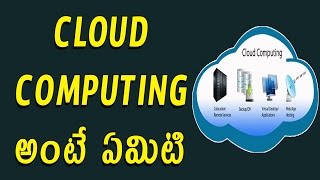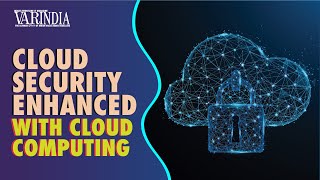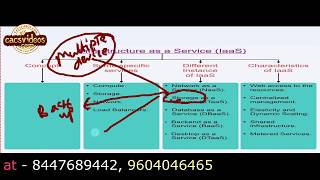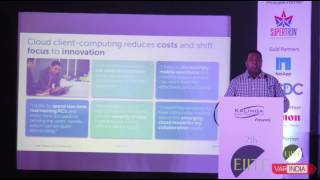Hi friends in this video you can learn what is Cloud Computing In Telugu
hafiztime
hafiz telugu videos
Watch Cloud Computing Explained In Telugu Telugu Video Tutorials With HD Quality.

Hi friends in this video you can learn what is Cloud Computing In Telugu
hafiztime
hafiz telugu videos
Watch Cloud Computing Explained In Telugu Telugu Video Tutorials With HD Quality
Technology video | 1281 views

Digital adoption is on all time high and cloud computing is emerging as a game changer and major enabler, across areas. Integrating cloud into your existing enterprise security program requires an assessment of your resources and business needs to develop a fresh approach to your culture and cloud security strategy. Cloud security is a set of policies, controls, procedures and technologies that should work together to protect your cloud-based applications and systems. From facilitating video conferencing for hybrid workplaces and empowering smart connected devices to helping accelerated growth of AI and ML through data driven insights, Cloud Computing has come a very long way from being just a virtual data storage platform. With increasing significance of Data, Cloud computing too is fast gaining importance among both, consumers as well as software and product development companies. And while these exciting new innovations powered by Cloud continue to disrupt various sectors across the globe, it is the silent yet powerful emergence of cloud as a potential enabler to fight of phishing and cybercrimes in the digital world.
Cybersecurity and regulatory compliance became the top two biggest concerns of corporate boards, some are adding cybersecurity experts specifically to scrutinize security and risk issues. It is ironic to note here that data security remained one of the chief concerns for businesses who hesitated the shift to cloud a few years ago. And now the same technology solution is helping to not just combat cybercrime but also became a potential platform that can empower other technologies like AI and ML to detect and prevent cybercrimes. As the new normal takes shape, all organizations will need an always-connected defensive posture, and clarity on what business risks remote users elevate to remain secure. The need of the hour is the brands and businesses seeking to ensure a safer cloud computing experience, need to also ensure that they work
Technology video | 191 views

Is Edge computing the most secure computing?
Is Edge computing the most secure computing?
Technology video | 275 views

There is a continued dialogue among (Cloud Vs Edge), on who will overtake whom. The future of edge computing is right around the corner. Experts feel that it has the power to protect the climate, improve our health, and squash road rage. However, even though cloud-based computing is great for many things, there are some drawbacks.
IDC forecasts the global edge computing market to reach $250 billion by 2024, with a compounded annual growth of 12.5%. No wonder the industry is talking about Edge Computing.
#Edgecomputing reclaims much of the storage and power that cloud computing took on over the years. Businesses are always trying to improve the reliability and performance of their software for users, while at the same time trying to reduce their own costs. We have seen how CDNs (content delivery networks) are an early form of edge software, with companies originally serving static content from locations closer to their users. The rise of CDNs has made it easier to roll out your entire application as close to your users as possible.
Edge computing is one of the 'new revolutionary technologies' that can change organizations wanting to break free from previous limitations of traditional cloud-based networks. The next 12-18 months will prove to be the natural inflection for edge computing. Practical applications are finally emerging where this architecture can bring real benefits.
91% of our data today is created and processed in centralized data centres. Cloud computing will continue to contribute to businesses regarding cost optimization, agility, resiliency, and innovation catalyst. But in the future, the 'Internet of Behaviours (IoB)' will power the next level of growth with endless new possibilities to re-imagine the products & services, user experiences, and operational excellence.
IoT, IIoT, AI, ML, Digital Twin, and Edge computing are at the core of the Internet of Behaviours. As per Gartner�
Technology video | 218 views

Odoo module is a set of business logic which helps to enhance the existing functionality or add some new functionality in Odoo.
This is hands-on video on Odoo 13 module creation. We will explain how to create module in Odoo.
www.bisptrainings.com, www.bispsolutions.com
For Odoo consulting visit: https://www.bispsolutions.com/
For Odoo training visit: https://www.bisptrainings.com/courses/odoo-technical-training
Register here for more details: https://www.bisptrainings.com/course-registration/odoo-technical-training
Please don’t Forget to Like, Share & Subscribe
Email Us: support@bisptrainings.com, support@bispsolutions.com
Call us: +91 7694095404 or +1 786-629-6893
Video Tutorial: https://www.youtube.com/playlist?list=PL7CWBDRZZ_QcdLoz-DtpAN_GYPrpRUTCh
Follow us on Facebook: https://www.facebook.com/bisptrainings/
Follow us on Twitter: https://twitter.com/bisptrainings
Follow us on Linkedin: https://www.linkedin.com/company/13367555/admin/
Odoo 13 Module Creation | Odoo 13 Tutorials | Odoo video tutorials | Odoo Training
Education video | 440 views

Watch Ch 8 ISCA Cloud Computing Model Missing Part for our Enrolled Students With HD Quality
Education video | 7947 views

Digital Inside: Tren Cloud Computing di 2019
Official Website: http://beritasatu.com
Facebook.com/BeritaSatu
Youtube.com/BeritaSatu
@BeritaSatu
Watch Digital Inside: Tren Cloud Computing di 2019 # 1 With HD Quality
News video | 1805 views

Digital Inside: Tren Cloud Computing di 2019
Official Website: http://beritasatu.com
Facebook.com/BeritaSatu
Youtube.com/BeritaSatu
@BeritaSatu
Watch Digital Inside: Tren Cloud Computing di 2019 # 2 With HD Quality
News video | 1042 views

Cloud Client Computing reduces costs and shift focus to innovation : Shamik Roy, Product Specialist – Pre Sales, Cloud Client Computing, Dell India at 7th EIITF 2016, Kolkata
Watch Cloud Client Computing reduces costs and shift focus to innovation : Shamik Roy With HD Quality
Vlogs video | 363 views

cloud computing bring agility to Financial Services
cloud computing bring agility to Financial Services
Technology video | 140 views

Subscribe to my Vlog Channel - Nidhi Katiyar Vlogs
https://www.youtube.com/channel/UCVgQXr1OwlxEKKhVPCTYlKg
-----------------------------------------------------------------------------------------------------------------------------
My Referal Codes -
Plum Goodness -
Use code - NK15 for 15% off
https://plumgoodness.com/discount/NK15
Re'equil - Use Code - NIDHIKATIYAR FOR 10%OFF
https://bit.ly/3ofrJhl
Mamaearth - Use Code nidhi2021 for 20% off
colorbar cosmetics - CBAFNIDHIKA20
Watch My other Vlogs -
https://www.youtube.com/watch?v=ih_bKToLC3g&list=PLswt2K44s-hbKsvEBLEC5fHDkEp7Wwnpd
Watch My Disney Princess to Indian Wedding Series here - Its fun to watch Indian Avatar of Disney Princesses -
https://www.youtube.com/watch?v=lPkRbupcUB0&list=PLswt2K44s-haUOABjzzUOG2jwUh_Fpr96
Watch My Monotone Makeup Looks Here -
https://www.youtube.com/watch?v=WrpPx-_F1Yw&list=PLswt2K44s-hZOfXt-sSQlVe7C_vBOjsWQ
Love Affordable Makeup - Checkout What's new in Affordable -
https://www.youtube.com/watch?v=lowjaZ9kZcs&list=PLswt2K44s-hZcQ-tZUr7GzH0ymkV18U8o
Here is my Get UNREADY With Me -
https://www.youtube.com/watch?v=aLtDX9l8ovo&list=PLswt2K44s-hbLjRz8rtj8FTC-3tZ55yzY
-----------------------------------------------------------------------------------------------------------------------------------
Follow me on all my social media's below:
email :team.nidhivlogs@gmail.com
Facebook: https://www.facebook.com/prettysimplenk/
Twitter : https://twitter.com/nidhikatiyar167
Instagram - https://www.instagram.com/nidhi.167/
Shop affordable Makeup here -
https://www.cuffsnlashes.com
------------------------------------------------------------------------------------------------------------------------------
Shop affordable Makeup here -
https://www.cuffsnlashes.com
Subscribe to my other channel 'Cuffs
Beauty Tips video | 18981 views

Styling Pakistani suit from @Meesho #shorts #meeshosuithaul #pakistanisuits #meeshokurti
Beauty Tips video | 3996 views

Barbie makeup- cut crease eye look - pink makeup for beginners #shorts #cutcrease #pinkeyelook Flat 25% off on Cuffs n Lashes entire range + free gift on all orders above 299
Cuffs n Lashes X Shystyles eyeshadow Palette - Seductress https://www.purplle.com/product/cuffs-n-lashes-x-shystyles-the-shystyles-palette-12-color-mini-palette-seductress
Cuffs n Lashes Eyelashes - Pink City - https://www.purplle.com/product/cuffs-n-lashes-5d-eyelashes-17-pink-city
Cuffs n Lashes Cover Pot - Nude - https://www.purplle.com/product/cuffs-n-lashes-cover-pots-nude
Cuffs n Lashes F021 Fat top brush - https://www.purplle.com/product/cuff-n-lashes-makeup-brushes-f-021-flat-top-kabuki-brush
Cuffs n Lashes x Shsytyeles Brush - https://www.purplle.com/product/cuffs-n-lashes-x-shystyles-makeup-brush-cs01-flat-shader-brush
Cuffs n Lashes Flat shader Brush E004 - https://www.purplle.com/product/cuff-n-lashes-makeup-brushes-e004-big-lat-brush
Barbie makeup- cut crease eye look - pink makeup for beginners #shorts #cutcrease #pinkeyelook
Beauty Tips video | 4203 views

Latte Makeup but with Indian touch #shorts #lattemakeup #viralmakeuphacks #viralmakeuptrends #makeup
Beauty Tips video | 3632 views

No Makeup vs No Makeup Makeup look #shorts #nomakeupmakeup #nofilter #naturalmakeup #everydaymakeup
Beauty Tips video | 4093 views

The Purplle I Heart Beauty Sale goes live on the 2nd of August!
BUY 1 GET 1 FREE on all mCaffeine products.
mCaffeine Cherry Affair - Coffee Face Mist - https://mlpl.link/INFIwj2Q
mCaffeine On The Go Coffee Body Stick - https://mlpl.link/INF3lvBa
Download the Purplle app here:
https://mlpl.link/JCCZ2INF
Subscribe to my Vlog Channel - Nidhi Katiyar Vlogs
https://www.youtube.com/channel/UCVgQXr1OwlxEKKhVPCTYlKg
-----------------------------------------------------------------------------------------------------------------------------
Watch My other Vlogs -
https://www.youtube.com/watch?v=ih_bKToLC3g&list=PLswt2K44s-hbKsvEBLEC5fHDkEp7Wwnpd
Watch My Disney Princess to Indian Wedding Series here - Its fun to watch Indian Avatar of Disney Princesses -
https://www.youtube.com/watch?v=lPkRbupcUB0&list=PLswt2K44s-haUOABjzzUOG2jwUh_Fpr96
Watch My Monotone Makeup Looks Here -
https://www.youtube.com/watch?v=WrpPx-_F1Yw&list=PLswt2K44s-hZOfXt-sSQlVe7C_vBOjsWQ
Love Affordable Makeup - Checkout What's new in Affordable -
https://www.youtube.com/watch?v=lowjaZ9kZcs&list=PLswt2K44s-hZcQ-tZUr7GzH0ymkV18U8o
Here is my Get UNREADY With Me -
https://www.youtube.com/watch?v=aLtDX9l8ovo&list=PLswt2K44s-hbLjRz8rtj8FTC-3tZ55yzY
-----------------------------------------------------------------------------------------------------------------------------------
Follow me on all my social media's below:
email :team.nidhivlogs@gmail.com
Facebook: https://www.facebook.com/prettysimplenk/
Twitter : https://twitter.com/nidhikatiyar167
Instagram - https://www.instagram.com/nidhi.167/
Shop affordable Makeup here -
https://www.cuffsnlashes.com
------------------------------------------------------------------------------------------------------------------------------
Shop affordable Makeup here -
https://www.cuffs
Beauty Tips video | 3846 views

Join Our Bartending School The Spirit Vidyalaya, Call us on 7558204535
Check out our website - www.cocktailsindia.com
Check out my Podcast - 'Dada Bartender Podcast' https://open.spotify.com/show/0ub0ll4SUUWwHDo5qk5Nb5?si=7b3ac81e1c194caf
Please follow me on Instagram: https://www.instagram.com/cocktailsindia2016/
Instagram (2): www.instagram.com/dada.bartender
Please follow me on Facebook: https://www.facebook.com/profile.php?id=100092566239501&mibextid=LQQJ4d
For Business / Suggestion: dada@cocktailsindia.com
sponsor.cocktailsindia@gmail.com
Affiliate Link
********************************************************************
My Camera - Canon EOS 200D II - Link To Purchase - https://amzn.to/3ZXuNQD
My Best Camera - Sony A7 3 - https://amzn.to/3ZjAkAJ
My Sound - GODOX MoveLink M2 - https://amzn.to/3JcqaMJ
My Light setup - GODOX LC500R RGB LED Light Stick - https://amzn.to/3SQmu6P
My Lens Setup - Sigma 18-35mm f/1.8 DC for Canon - https://amzn.to/3ZDqbyD
My Lens Setup - Canon EF50MM F/1.8 STM Lens - https://amzn.to/41CEeX4
My Audio Setup - Zoom H1n Handy Recorder - https://amzn.to/3mudhFa
Home Bar Accessories - https://amzn.to/3LedEOv
Glassware - https://amzn.to/3KRPSrf
Ice mould - https://amzn.to/3EWlecr
Disclaimer:
The purpose of this channel is not to support or encourage underage drinking but to provide knowledge of the products we consume. This channel does not promote or sell any alcoholic product. The purpose of this channel is to strictly entertain and inform people about products available on the market. We are strictly against underage drinking and do not support it.
About The Channel:-
If you love homestyle cocktails, reviews of Alcohol, Drink knowledge, Bartending and many more then this channel is for you. India is the biggest alcohol consumer in the world. We buy and consume more whiskey in the worl
Cooking video | 16747 views

Kolkata’s Best Bartending School with LAB Felicity “The Spirit Vidyalaya”. If you love bartending then come and join us
Please call Sourav +91 755-8204535 for further dissertation. Thanks
What My Students Speaking? About My Bartending School “The Spirit Vidyalaya” Kolkata
Cooking video | 4111 views

PEG क्या है, इसे PEG क्यों कहा जाता है? | What Is Peg
Join Our Bartending School The Spirit Vidyalaya, Call us on 7558204535
Check out our website - www.cocktailsindia.com
Check out my Podcast - 'Dada Bartender Podcast' https://open.spotify.com/show/0ub0ll4SUUWwHDo5qk5Nb5?si=7b3ac81e1c194caf
Please follow me on Instagram: https://www.instagram.com/cocktailsindia2016/
Instagram (2): www.instagram.com/dada.bartender
Please follow me on Facebook: https://www.facebook.com/profile.php?id=100092566239501&mibextid=LQQJ4d
For Business / Suggestion: dada@cocktailsindia.com
sponsor.cocktailsindia@gmail.com
Affiliate Link
********************************************************************
My Camera - Canon EOS 200D II - Link To Purchase - https://amzn.to/3ZXuNQD
My Best Camera - Sony A7 3 - https://amzn.to/3ZjAkAJ
My Sound - GODOX MoveLink M2 - https://amzn.to/3JcqaMJ
My Light setup - GODOX LC500R RGB LED Light Stick - https://amzn.to/3SQmu6P
My Lens Setup - Sigma 18-35mm f/1.8 DC for Canon - https://amzn.to/3ZDqbyD
My Lens Setup - Canon EF50MM F/1.8 STM Lens - https://amzn.to/41CEeX4
My Audio Setup - Zoom H1n Handy Recorder - https://amzn.to/3mudhFa
Home Bar Accessories - https://amzn.to/3LedEOv
Glassware - https://amzn.to/3KRPSrf
Ice mould - https://amzn.to/3EWlecr
Disclaimer:
The purpose of this channel is not to support or encourage underage drinking but to provide knowledge of the products we consume. This channel does not promote or sell any alcoholic product. The purpose of this channel is to strictly entertain and inform people about products available on the market. We are strictly against underage drinking and do not support it.
About The Channel:-
If you love homestyle cocktails, reviews of Alcohol, Drink knowledge, Bartending and many more then this channel is for you. India is the biggest alcohol con
Cooking video | 3993 views

What is Wheat Beer? | व्हीट बीयर क्या है?
Join Our Bartending School The Spirit Vidyalaya, Call us on 7558204535
Check out our website - www.cocktailsindia.com
Check out my Podcast - 'Dada Bartender Podcast' https://open.spotify.com/show/0ub0ll4SUUWwHDo5qk5Nb5?si=7b3ac81e1c194caf
Please follow me on Instagram: https://www.instagram.com/cocktailsindia2016/
Instagram (2): www.instagram.com/dada.bartender
Please follow me on Facebook: https://www.facebook.com/profile.php?id=100092566239501&mibextid=LQQJ4d
For Business / Suggestion: dada@cocktailsindia.com
sponsor.cocktailsindia@gmail.com
Affiliate Link
********************************************************************
My Camera - Canon EOS 200D II - Link To Purchase - https://amzn.to/3ZXuNQD
My Best Camera - Sony A7 3 - https://amzn.to/3ZjAkAJ
My Sound - GODOX MoveLink M2 - https://amzn.to/3JcqaMJ
My Light setup - GODOX LC500R RGB LED Light Stick - https://amzn.to/3SQmu6P
My Lens Setup - Sigma 18-35mm f/1.8 DC for Canon - https://amzn.to/3ZDqbyD
My Lens Setup - Canon EF50MM F/1.8 STM Lens - https://amzn.to/41CEeX4
My Audio Setup - Zoom H1n Handy Recorder - https://amzn.to/3mudhFa
Home Bar Accessories - https://amzn.to/3LedEOv
Glassware - https://amzn.to/3KRPSrf
Ice mould - https://amzn.to/3EWlecr
Disclaimer:
The purpose of this channel is not to support or encourage underage drinking but to provide knowledge of the products we consume. This channel does not promote or sell any alcoholic product. The purpose of this channel is to strictly entertain and inform people about products available on the market. We are strictly against underage drinking and do not support it.
About The Channel:-
If you love homestyle cocktails, reviews of Alcohol, Drink knowledge, Bartending and many more then this channel is for you. India is the biggest alcohol consumer in th
Cooking video | 3781 views

भारत में पहला BAR कौन सा है? Which is the First BAR in India? Do you know?
#firstbar #Indiasfirstbar #bar #cocktailsindia
Check out my Podcast - 'Dada Bartender Podcast' https://open.spotify.com/show/0ub0ll4SUUWwHDo5qk5Nb5?si=7b3ac81e1c194caf
Please follow me on Instagram: https://www.instagram.com/cocktailsindia2016/
Please follow me on Facebook: https://www.facebook.com/cocktailsindia1975/
For Business / Suggestion: sponsor.cocktailsindia@gmail.com
Affiliate Link
********************************************************************
My Camera - Canon EOS 200D II - Link To Purchase - https://amzn.to/3ZXuNQD
My Best Camera - Sony A7 3 - https://amzn.to/3ZjAkAJ
My Sound - GODOX MoveLink M2 - https://amzn.to/3JcqaMJ
My Light setup - GODOX LC500R RGB LED Light Stick - https://amzn.to/3SQmu6P
My Lens Setup - Sigma 18-35mm f/1.8 DC for Canon - https://amzn.to/3ZDqbyD
My Lens Setup - Canon EF50MM F/1.8 STM Lens - https://amzn.to/41CEeX4
My Audio Setup - Zoom H1n Handy Recorder - https://amzn.to/3mudhFa
Home Bar Accessories - https://amzn.to/3LedEOv
Glassware - https://amzn.to/3KRPSrf
Ice mould - https://amzn.to/3EWlecr
Disclaimer:
The purpose of this channel is not to support or encourage underage drinking but to provide knowledge of the products we consume. This channel does not promote or sell any alcoholic product. The purpose of this channel is to strictly entertain and inform people about products available on the market. We are strictly against underage drinking and do not support it.
About The Channel:-
If you love homestyle cocktails, reviews of Alcohol, Drink knowledge, Bartending and many more then this channel is for you. India is the biggest alcohol consumer in the world. We buy and consume more whiskey in the world than anyone else. This channel helps give information about your favorite drink. How to make fantastic cocktails at ho
Cooking video | 3713 views

एक Wine की बोतल की सेल्फ लाइफ क्या होती है? What is the shelf-life of a bottle of wine?
#wine #Wineshelflife #cocktailsindia #dadabartender
Join Our Bartending School The Spirit Vidyalaya, Call us on 7558204535
Check out our website - www.cocktailsindia.com
Check out my Podcast - 'Dada Bartender Podcast' https://open.spotify.com/show/0ub0ll4SUUWwHDo5qk5Nb5?si=7b3ac81e1c194caf
Please follow me on Instagram: https://www.instagram.com/cocktailsindia2016/
Instagram (2): www.instagram.com/dada.bartender
Please follow me on Facebook: https://www.facebook.com/profile.php?id=100092566239501&mibextid=LQQJ4d
For Business / Suggestion: dada@cocktailsindia.com
sponsor.cocktailsindia@gmail.com
Affiliate Link
********************************************************************
My Camera - Canon EOS 200D II - Link To Purchase - https://amzn.to/3ZXuNQD
My Best Camera - Sony A7 3 - https://amzn.to/3ZjAkAJ
My Sound - GODOX MoveLink M2 - https://amzn.to/3JcqaMJ
My Light setup - GODOX LC500R RGB LED Light Stick - https://amzn.to/3SQmu6P
My Lens Setup - Sigma 18-35mm f/1.8 DC for Canon - https://amzn.to/3ZDqbyD
My Lens Setup - Canon EF50MM F/1.8 STM Lens - https://amzn.to/41CEeX4
My Audio Setup - Zoom H1n Handy Recorder - https://amzn.to/3mudhFa
Home Bar Accessories - https://amzn.to/3LedEOv
Glassware - https://amzn.to/3KRPSrf
Ice mould - https://amzn.to/3EWlecr
Disclaimer:
The purpose of this channel is not to support or encourage underage drinking but to provide knowledge of the products we consume. This channel does not promote or sell any alcoholic product. The purpose of this channel is to strictly entertain and inform people about products available on the market. We are strictly against underage drinking and do not support it.
About The Channel:-
If you love homestyle cocktails, reviews of Alcohol, Drink kn
Cooking video | 3737 views